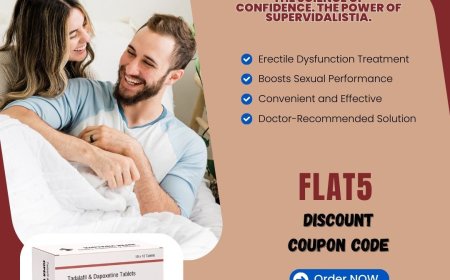The Role of Core Web Vitals in Modern Website Optimization
Website optimization is the process of working on different aspects of a website to improve its performance, usability, and ranking on search engines.

Website optimization is the process of working on different aspects of a website to improve its performance, usability, and ranking on search engines. Goodwebsite SEO optimization has always been important in drawing in people and making them stay in the digital market today. It consists of technical fixes, content creation, and user experience upgrades that make the site sift through search engines like Google quite easily.
Website optimization is also about becoming an SEO partner service provider to better help clients find the weak links and fine-tune optimization strategies for visibility and traffic. Focus on website SEO, and your company can attain better organic search results, bringing in highly qualified leads for added conversion.
In this guide, we will explore how Core Web Vitalsa set of user-focused metrics introduced by Googlehave become paramount for the modern-day website optimization. And here lies the essence: understanding and working on these metrics for an impressive user experience and just so great SEO will result in a wonderfully optimized website.
Understanding Core Web Vitals in SEO Optimization
Core Web Vitals are a series of key performance metrics introduced by Google to assess real-world user experience on websites. Since they bear a direct influence on how users perceive and use a site, these metrics have become instrumental in website SEO optimization. Thus enhancing Core Web Vitals has become one of the main focuses of any SEO optimization service hoping to improve a site's ranking and overall performance.
The three Core Web Vitals are:
Largest Contentful Paint (LCP) measures how fast the main content of a page loads. Fast LCP lets users view meaningful content sooner, hence improving user engagement and reduces bounce rates.
First Input Delay (FID) measures the time from when a user interacts for the first time with your website until the browser processes that interaction. A very low FID will allow users to interact smoothly without any frustrating delays.
Cumulative Layout Shift (CLS) tracks unexpected layout shifts during page load, which may cause users to click the wrong element or others. A low score means the layout will remain stable and visually consistent.
Working on the Core Web Vitals is vital for successful website optimization and gaining higher SEO rankings for the website. Within a site's ranking mechanism, Google has started considering these metrics; thus, upping your site's optimization through them will give you leverage in the search listings.
Key Core Web Vitals Metrics for Website SEO Optimization
When improving website SEO optimization, it is significant to understand the Core Web Vitals since they influence the experience of the users and rankings on the search engines. Let us look deeper into these three core metrics:
1 Largest Contentful Paint (LCP) and Its Impact
LCP stands for Largest Contentful Paint and measures how quickly the main page content is rendered on the screen for the user. For successful website optimization, the LCP must ideally occur within 2.5 seconds after the commencement of page loading. A slow LCP can frustrate visitors, increase bounce rates, and be detrimental to your website SEO. Common ways used by an SEO optimization service to improve LCP include optimizing images, improving server response time, and reducing render-blocking resources.
2 First Input Delay (FID) for User Interaction
FID records the time passing between the first interaction of the user with the site (for example, by clicking on a button) and when the browser begins to react to that interaction. A very low FID, ie., less than 100 ms, can give users the feeling of fast and smooth working of the website, which is a very crucial point in their engagement and in ranking high in search engines. Optimization of JavaScript execution and reduction of heavy scripts are some of the ways by which FID could be decreased.
3 Cumulative Layout Shift (CLS) and Visual Stability
CLS measures the extent of unexpected layout shifts that happen during the life of a webpage. Layout shifts can distract and make users accidentally click on the wrong thing, which affects the experience negatively. A good CLS score is below 0.1. Visual stability enhances both user experience and website SEO rankings.
Focusing on these Core Web Vitals will give businesses a better ranking in their SEO-enhanced website and also ensure the optimization of the overall website.
How Core Web Vitals Affect SEO Optimization Service Outcomes
Core Web Vitals are now the chief determinants in anything SEO Optimization Service undertakes toward improving the website SEO and further website optimizations. Keeping in line with the Page Experience update, Core Web Vitals now stand as Ranking Signals; therefore, optimizing Core Web Vitals means directly impacting the positioning of your website within Google searches.
1 The Page Experience with Regards to SEO Rankings
Recent Google algorithm updates give the utmost priority to websites offering a fast, responsive, and visually stable experience to their users. In that sense, even the finest content would have trouble ranking if the site does not meet the Core Web Vitals thresholds. This has now made Core Web Vitals optimization a prerogative in competitive search rankings for any business spending on Website SEO Optimization.
2 Case Studies for Website SEO Improvement
Numerous companies have reported measurable improvements after establishing Core Web Vitals as part of their SEO strategy. For instance, LCP reduction improves engagement and lowers bounce rates while optimizations could include better images and server response time. Reducing FID through better JavaScript and decreasing interaction times has given visitors more time on site.
This then translates into greater organic traffic, higher conversion rates, and more growth for the business when working with an SEO optimization service. Ignoring Core Web Vitals can allow SEO efforts to underperform despite having quality content and backlinks.
Tools and Techniques in Website SEO Optimization
In order to very well improve Core Web Vitals as well as overall website SEO optimization, the right tools and techniques have to be employed. These tools correspondingly help the business or SEO optimization services provider in identifying the issues and keeping track of website SEO improvement performance.
1 Tools for Measuring Core Web Vitals
The following tools provide deep-dive analytics services for Core Web Vitals metrics:
Google PageSpeed Insights: Offers easy-to-understand reports on LCP, FID, CLS, and other performance metrics. Suggestions for addressing these issues accompany the report. Perfect for any site owner interested in improving their website.
Google Search Console: Tracks improvements and alerts site owners to pages in trouble by reporting Core Web Vitals for real users at large within your site.
Lighthouse and Chrome DevTools: Profile and evaluate webpage issues based on Core Web Vitals and SEO.
2 Core Web Vitals SEO Optimization Best Practices
Several practices should be emphasized while developing an effective Website SEO optimization program:
Compress images and use modern formats such as WebP.
Minimize JavaScript and CSS for faster loading and responsiveness.
Use lazy loading to load content off screen only when it is needed.
Prevent layout shifts by specifying size attributes for images and ads.
When combined with proven techniques, an SEO Optimization Service will yield real results in the scores of Core Web Vitals as well as on Web SEO performance.
Recurring Issues in Website SEO Optimization
Many issues keep popping up within the majority of websites, thus restricting their Web SEO optimization attempts and affecting their Core Web Vitals. Knowing and acknowledging these issues is the first step toward dealing with them through your SEO Optimization Service.
1 Performance Issues Affecting SEO
Slow Server Response Times: A slow server increases the time it takes for pages to load and deteriorates the Largest Contentful Paint (LCP) and general user experience.
Render-blocking Resources: Too many or poorly optimized JavaScript and CSS files delay the rendering of contents, and this affects both LCP and First Input Delay (FID).
Unoptimized Images: Large uncompressed images slow loading speed and worsen the Core Web Vitals scores.
2 Resolving SEO Optimization Problems Related to Core Web Vitals
Unexpected Layout Shifts: Failing to provide size attributes for images or ads causes visual instability, thus increasing Cumulative Layout Shift (CLS).
Heavy JavaScript Execution: Complex scripts delay interactivity, thereby increasing First Input Delay (FID).
Poor Mobile Optimization: Since most browsing is done on mobile, lack of optimization for mobile performance will severely downgrade SEO rankings.
Take a proactive approach in fixing these challenges with a targeted Website SEO Optimization approach, thus leading to improved Core Web Vitals scores, increased search rankings, and much enhanced user experience.
Implementing a Comprehensive SEO Optimization Service
Ensuring a good SEO for a website needs to have a strategic approach to Core Web Vitals and site performance. An SEO service will have the ability to implement the following strategies that are directed at upgrading a website in terms of user experience and ranking.
1 Strategies to Enhance Core Web Vitals
LCP Improvement: Optimize images by compressing them, select better hosting options, and enable caching for faster loading.
Enhancing FID: Minimize and defer JavaScripts for interactivity speed; breaking up long tasks, optimizing event handlers.
Lowering CLS: Reserve space for images and ads by setting dimensions; avoid inserting content above existing elements; use CSS for layout stabilization.
2 Long-Term Plans for Website SEO Optimization
Continuous Monitoring: Core Web Vitals and associated SEO metrics should be tracked using tools like Google Search Console.
Content Quality and Relevance: High-quality, keyword-based content that complies with user intent must be maintained alongside tech optimization.
Mobile-first Optimization: Make sure your website is fully responsive and executes well across all devices, as great importance lies on mobile usability from an SEO perspective.
Improvements to Page Experience: To provide a smooth user experience, this includes better site navigation, limiting intrusive pop-ups, and boosting accessibility.
When combined, these technical and content-based approaches allow an SEO optimization service to offer a sustainable approach for the furtherance of website SEO and site optimization.
Website Optimization and SEOs Future Perspective
With time, the digital world is gradually drifting towards a mere website being a sophisticated and user-centric solution. Being ahead in the game will mean adapting to newer trends and technologies that will determine how SEO optimization services will look to build and sustain businesses.
1 Emerging Trends in Website SEO Optimization
Core Web Vitals Evolution: Google is expected to refine and expand the set of user experience metrics beyond the current Core Web Vitals, making ongoing optimization a continuous process.
AI-Powered SEO Tools: Artificial intelligence and machine learning will play a bigger role in automating SEO tasks, analyzing user behavior, and delivering personalized website experiences.
Voice Search and Visual Search: Optimizing for voice commands and image-based searches will become increasingly important as these search methods gain popularity.
Mobile-First and Beyond: With mobile traffic dominating, further enhancements to mobile usability and speed will be essential for effective website SEO optimization.
2 Preparing for Next-Gen SEO Optimization Service
Focus on User Intent: SEO will increasingly prioritize understanding and meeting user intent through more relevant and engaging content.
Holistic Page Experience: Beyond technical metrics, factors like content quality, security (HTTPS), and accessibility will be crucial ranking signals.
Integration of SEO with Digital Marketing: Combining SEO efforts with broader digital marketing strategiessuch as content marketing, social media, and paid advertisingwill maximize website success.
By anticipating these trends, businesses and SEO optimization services can future-proof their website optimization strategies to stay competitive in search rankings and deliver exceptional user experiences.
Conclusion
Core Web Vitals have taken a life of their own ever since modern website optimization and website SEO entered the scene. Since these are just the metrics you can use, understanding them and utilizing them with the whole SEO effort gives you a better chance of improving site performance and user experience as well as search engine rankings.
Working with a professional SEO optimization service that will not just get your website through with technical factors but also ascertain that it conforms to best practice in terms of content and usability is the way to optimize website SEO. In today's very competitive online environment, this compact solution to website SEO optimization is an absolute necessity for success in the long run.
In a nutshell, making SEO optimization work requires work. Constant evaluation and enhancement of Core Web Vitals and other SEO factors will create visibility for your website and ensure that it gets a load of visitors, which will further enhance business growth.












































